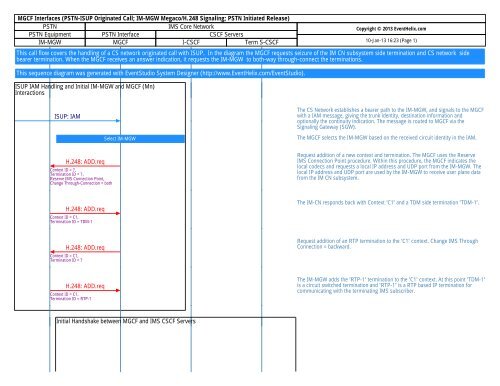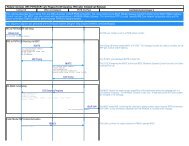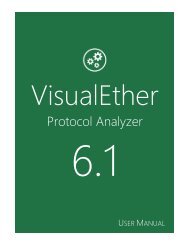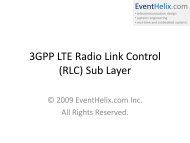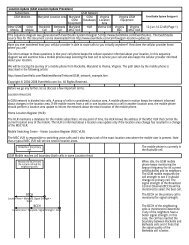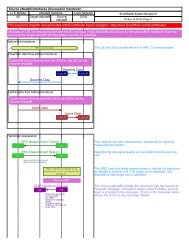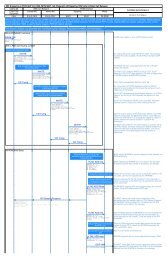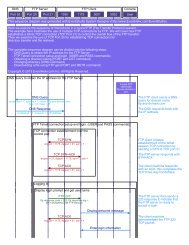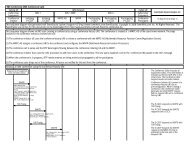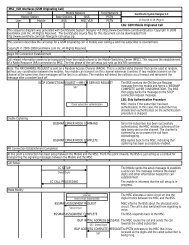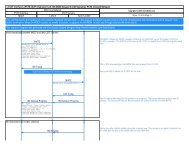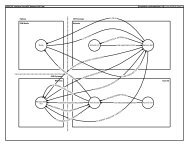MGCF Call Flow - EventHelix.com
MGCF Call Flow - EventHelix.com
MGCF Call Flow - EventHelix.com
Create successful ePaper yourself
Turn your PDF publications into a flip-book with our unique Google optimized e-Paper software.
<strong>MGCF</strong> Interfaces (PSTN-ISUP Originated <strong>Call</strong>; IM-MGW Megaco/H.248 Signaling; PSTN Initiated Release)<br />
PSTN<br />
IMS Core Network<br />
PSTN Equipment PSTN Interface CSCF Servers<br />
IM-MGW <strong>MGCF</strong> I-CSCF Term S-CSCF<br />
Copyright © 2013 <strong>EventHelix</strong>.<strong>com</strong><br />
10-Jan-13 16:23 (Page 1)<br />
This call flow covers the handling of a CS network originated call with ISUP. In the diagram the <strong>MGCF</strong> requests seizure of the IM CN subsystem side termination and CS network side<br />
bearer termination. When the <strong>MGCF</strong> receives an answer indication, it requests the IM-MGW to both-way through-connect the terminations.<br />
This sequence diagram was generated with EventStudio System Designer (http://www.<strong>EventHelix</strong>.<strong>com</strong>/EventStudio).<br />
ISUP IAM Handling and Initial IM-MGW and <strong>MGCF</strong> (Mn)<br />
Interactions<br />
ISUP: IAM<br />
The CS Network establishes a bearer path to the IM-MGW, and signals to the <strong>MGCF</strong><br />
with a IAM message, giving the trunk identity, destination information and<br />
optionally the continuity indication. The message is routed to <strong>MGCF</strong> via the<br />
Signaling Gateway (SGW).<br />
Select IM-MGW<br />
The <strong>MGCF</strong> selects the IM-MGW based on the received circuit identity in the IAM.<br />
H.248: ADD.req<br />
Context ID = ?,<br />
Termination ID = ?,<br />
Reserve IMS Connection Point,<br />
Change Through-Connection = both<br />
Request addition of a new context and termination. The <strong>MGCF</strong> uses the Reserve<br />
IMS Connection Point procedure. Within this procedure, the <strong>MGCF</strong> indicates the<br />
local codecs and requests a local IP address and UDP port from the IM-MGW. The<br />
local IP address and UDP port are used by the IM-MGW to receive user plane data<br />
from the IM CN subsystem.<br />
H.248: ADD.req<br />
Context ID = C1,<br />
Termination ID = TDM-1<br />
The IM-CN responds back with Context "C1" and a TDM side termination "TDM-1".<br />
H.248: ADD.req<br />
Context ID = C1,<br />
Termination ID = ?<br />
Request addition of an RTP termination to the "C1" context. Change IMS Through<br />
Connection = backward.<br />
H.248: ADD.req<br />
Context ID = C1,<br />
Termination ID = RTP-1<br />
The IM-MGW adds the "RTP-1" termination to the "C1" context. At this point "TDM-1"<br />
is a circuit switched termination and "RTP-1" is a RTP based IP termination for<br />
<strong>com</strong>municating with the terminating IMS subscriber.<br />
Initial Handshake between <strong>MGCF</strong> and IMS CSCF Servers
<strong>MGCF</strong> Interfaces (PSTN-ISUP Originated <strong>Call</strong>; IM-MGW Megaco/H.248 Signaling; PSTN Initiated Release)<br />
PSTN<br />
IMS Core Network<br />
PSTN Equipment PSTN Interface CSCF Servers<br />
IM-MGW <strong>MGCF</strong> I-CSCF Term S-CSCF<br />
INVITE<br />
INVITE tel:1-811-CALLED SIP/2.0,<br />
Via: ;branch,<br />
Route: ,<br />
P-Asserted-Identity: ,<br />
Contact: ,<br />
m=audio 3456 RTP/AVP 97 96,<br />
a=curr:qos local none,<br />
a=curr:qos remote none,<br />
a=des:qos mandatory local sendrecv,<br />
a=des:qos none remote sendrecv<br />
Copyright © 2013 <strong>EventHelix</strong>.<strong>com</strong><br />
10-Jan-13 16:23 (Page 2)<br />
The <strong>MGCF</strong> initiates an INVITE request, containing an initial SDP, as per the proper<br />
S-CSCF to S-CSCF procedure. The INVITE is first sent to the I-CSCF to identify the<br />
S-CSCF serving the called user.<br />
100 Trying<br />
183 Session Progress<br />
Via: ,<br />
Record-Route: <br />
,<br />
Contact: <br />
:Port,<br />
m=audio 6544 RTP/AVP 97 96,<br />
a=curr:qos local none,<br />
a=curr:qos remote none,<br />
a=des:qos mandatory local<br />
sendrecv,<br />
a=des:qos mandatory remote<br />
sendrecv<br />
The I-CSCF acknowledges the INVITE that was received from P-CSCF.<br />
The UE replies indicating that the session is in progress. The contact address is set<br />
its own IP address. The Via and the Record-Route headers are copied from the<br />
received INVITE.<br />
Mn Interactions for Codec selection<br />
H.248: MOD.req<br />
Context ID = C1,<br />
Termination ID = RTP-1<br />
The <strong>MGCF</strong> indicates the remote IP address and UDP port, i.e. the destination IP<br />
address and UDP port for RTP messages sent towards the terminating IMS UE. It<br />
also identifies the codec to be used in the IM-MGW to Terminating UE RTP<br />
<strong>com</strong>munication.<br />
H.248: MOD.resp<br />
Context ID = C1,<br />
Termination ID = RTP-1<br />
Reply to <strong>MGCF</strong>. The final codec selection is indicated.<br />
PRACK<br />
a=curr:qos local sendrecv,<br />
a=curr:qos remote none,<br />
a=des:qos mandatory local sendrecv,<br />
a=des:qos mandatory remote sendrecv<br />
The <strong>Call</strong>er now sends a PRACK to inform the called subscriber about the selected<br />
Codec. The message also indicates that currently the resources needed for meeting<br />
the quality of service requirements of the session are already available ("a=curr:qos<br />
local sendrecv").<br />
200 OK (PRACK)<br />
This "200 OK" just acknowledges PRACK.
<strong>MGCF</strong> Interfaces (PSTN-ISUP Originated <strong>Call</strong>; IM-MGW Megaco/H.248 Signaling; PSTN Initiated Release)<br />
PSTN<br />
IMS Core Network<br />
PSTN Equipment PSTN Interface CSCF Servers<br />
IM-MGW <strong>MGCF</strong> I-CSCF Term S-CSCF<br />
180 Ringing<br />
Copyright © 2013 <strong>EventHelix</strong>.<strong>com</strong><br />
10-Jan-13 16:23 (Page 3)<br />
Inform the caller that the called subscriber is being rung. This serves as an implicit<br />
indication to the caller that the QoS at the called side has also been met.<br />
PRACK<br />
The caller acknowledges the ringing message.<br />
200 OK (PRACK)<br />
The called subscriber acknowledges the PRACK.<br />
ISUP ACM related interactions on Mn interface.<br />
ISUP: ACM<br />
H.248: MOD.req<br />
Context ID = C1,<br />
Termination ID = TDM-1,<br />
procedure = Send TDM Tone<br />
The <strong>MGCF</strong> requests the IM-MGW to provide a ringing tone to the calling party using<br />
the Send TDM Tone procedure.<br />
H.248: MOD.resp<br />
Context ID = C1,<br />
Termination ID = TDM-1<br />
IMS Answer to ISUP ANM Handling<br />
200 OK (INVITE)<br />
Notify the caller that that the call has been answered.<br />
H.248: MOD.req<br />
Context ID = C1,<br />
Termination ID = TDM-1,<br />
procedure = Stop TDM Tone<br />
The call has been answered so the <strong>MGCF</strong> requests the IM-MGW to stop the ring<br />
tone on the TDM side.
<strong>MGCF</strong> Interfaces (PSTN-ISUP Originated <strong>Call</strong>; IM-MGW Megaco/H.248 Signaling; PSTN Initiated Release)<br />
PSTN<br />
IMS Core Network<br />
PSTN Equipment PSTN Interface CSCF Servers<br />
IM-MGW <strong>MGCF</strong> I-CSCF Term S-CSCF<br />
Copyright © 2013 <strong>EventHelix</strong>.<strong>com</strong><br />
10-Jan-13 16:23 (Page 4)<br />
H.248: MOD.resp<br />
Context ID = C1,<br />
Termination ID = TDM-1<br />
H.248: MOD.req<br />
Context ID = C1,<br />
Termination ID = RTP-1<br />
Request the IM-MGW to both-way through-connect the terminations using the<br />
Change IMS Through-Connection or Change TDM Through-Connection procedure.<br />
H.248: MOD.resp<br />
Context ID = C1,<br />
Termination ID = RTP-1<br />
ISUP: ANM<br />
ACK<br />
The caller acknowledges the "200 OK" message. The call is now ready to enter<br />
conversation mode.<br />
PSTN Initiated <strong>Call</strong> Release<br />
ISUP REL<br />
A call release has been received from the PSTN side.<br />
BYE<br />
<strong>MGCF</strong> initiates IMS side call release by sending BYE.<br />
H.248: SUB.req<br />
Context ID = C1,<br />
Termination ID = TDM1<br />
Request IM-MGW to Release TDM Termination. A Megaco SUBtract request is sent<br />
to release the PSTN side TDM circuit.<br />
H.248: SUB.resp<br />
Context ID = C1,<br />
Termination ID = TDM1<br />
IM-MGW acknowledges.
<strong>MGCF</strong> Interfaces (PSTN-ISUP Originated <strong>Call</strong>; IM-MGW Megaco/H.248 Signaling; PSTN Initiated Release)<br />
PSTN<br />
IMS Core Network<br />
PSTN Equipment PSTN Interface CSCF Servers<br />
IM-MGW <strong>MGCF</strong> I-CSCF Term S-CSCF<br />
Request IM-MGW to Release IMS Termination<br />
Copyright © 2013 <strong>EventHelix</strong>.<strong>com</strong><br />
10-Jan-13 16:23 (Page 5)<br />
H.248: SUB.req<br />
Context ID = C1,<br />
Termination ID = RTP1<br />
Request IM-MGW to Release RTP Termination. A Megaco SUBtract request is sent<br />
to release the IMS side RTP termination.<br />
H.248: SUB.resp<br />
Context ID = C1,<br />
Termination ID = RTP1<br />
IM-MGW acknowledges.<br />
ISUP RLC<br />
200 OK (BYE)<br />
<strong>MGCF</strong> signals ISUP Release Complete to the PSTN network.<br />
Acknowledge the BYE that was received from the IMS network.<br />
This sequence diagram was generated with EventStudio System Designer (http://www.<strong>EventHelix</strong>.<strong>com</strong>/EventStudio).
<strong>MGCF</strong> Interfaces (Alternate Scenario: <strong>Call</strong>ed IMS Subscriber Initiated <strong>Call</strong> Release)<br />
PSTN<br />
IMS Core Network<br />
PSTN Equipment PSTN Interface CSCF Servers<br />
IM-MGW <strong>MGCF</strong> I-CSCF Term S-CSCF<br />
Copyright © 2013 <strong>EventHelix</strong>.<strong>com</strong><br />
10-Jan-13 16:23 (Page 6)<br />
This call flow covers the handling of a CS network originated call with ISUP. In the diagram the <strong>MGCF</strong> requests seizure of the IM CN subsystem side termination and CS network side<br />
bearer termination. When the <strong>MGCF</strong> receives an answer indication, it requests the IM-MGW to both-way through-connect the terminations.<br />
This sequence diagram was generated with EventStudio System Designer (http://www.<strong>EventHelix</strong>.<strong>com</strong>/EventStudio).<br />
ISUP IAM Handling and Initial IM-MGW and <strong>MGCF</strong> (Mn)<br />
Interactions<br />
Initial Handshake between <strong>MGCF</strong> and IMS CSCF Servers<br />
Mn Interactions for Codec selection<br />
ISUP ACM related interactions on Mn interface.<br />
IMS Answer to ISUP ANM Handling<br />
<strong>Call</strong>ed Subsciber Initiates <strong>Call</strong> Release<br />
BYE<br />
BYE is sent to initiate the call.<br />
200 OK (BYE)<br />
<strong>MGCF</strong> acknowledges the receipt of the BYE message.<br />
ISUP REL<br />
H.248: SUB.req<br />
Context ID = C1,<br />
Termination ID = RTP1<br />
An ISUP Release message is sent to the PSTN.<br />
Request IM-MGW to Release RTP Termination. A Megaco SUBtract request is sent<br />
to release the IMS side RTP termination.<br />
H.248: SUB.resp<br />
Context ID = C1,<br />
Termination ID = RTP1<br />
IM-MGW acknowledges.<br />
Request IM-MGW to Release TDM Termination
<strong>MGCF</strong> Interfaces (Alternate Scenario: <strong>Call</strong>ed IMS Subscriber Initiated <strong>Call</strong> Release)<br />
PSTN<br />
IMS Core Network<br />
PSTN Equipment PSTN Interface CSCF Servers<br />
IM-MGW <strong>MGCF</strong> I-CSCF Term S-CSCF<br />
H.248: SUB.req<br />
Context ID = C1,<br />
Termination ID = TDM1<br />
Copyright © 2013 <strong>EventHelix</strong>.<strong>com</strong><br />
10-Jan-13 16:23 (Page 7)<br />
Request IM-MGW to Release TDM Termination. A Megaco SUBtract request is sent<br />
to release the PSTN side TDM circuit.<br />
H.248: SUB.resp<br />
Context ID = C1,<br />
Termination ID = TDM1<br />
IM-MGW acknowledges.<br />
ISUP RLC<br />
ISUP Release <strong>com</strong>plete is received from the PSTN side.<br />
This sequence diagram was generated with EventStudio System Designer (http://www.<strong>EventHelix</strong>.<strong>com</strong>/EventStudio).


